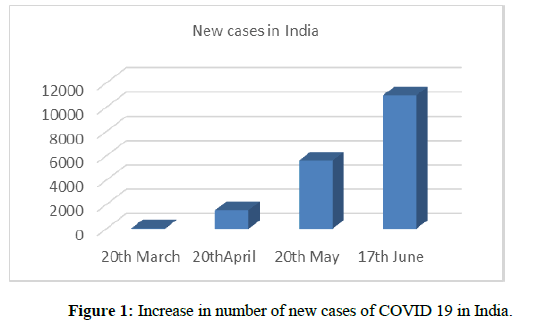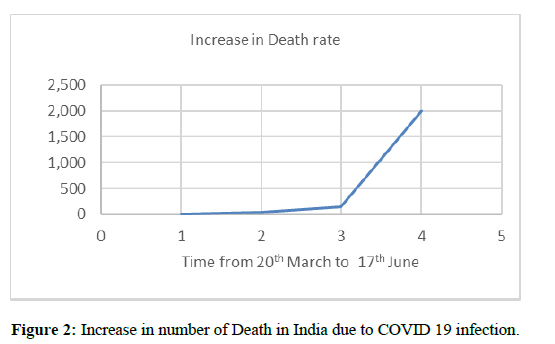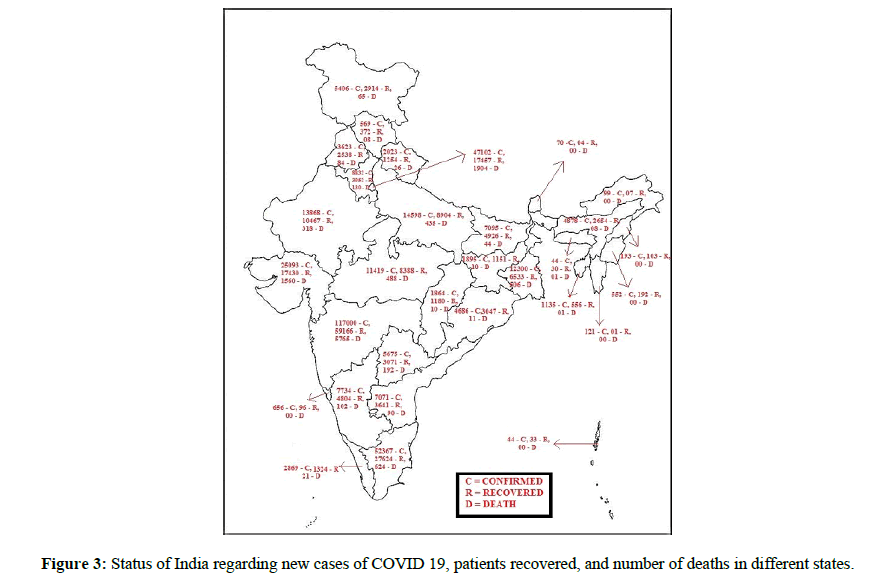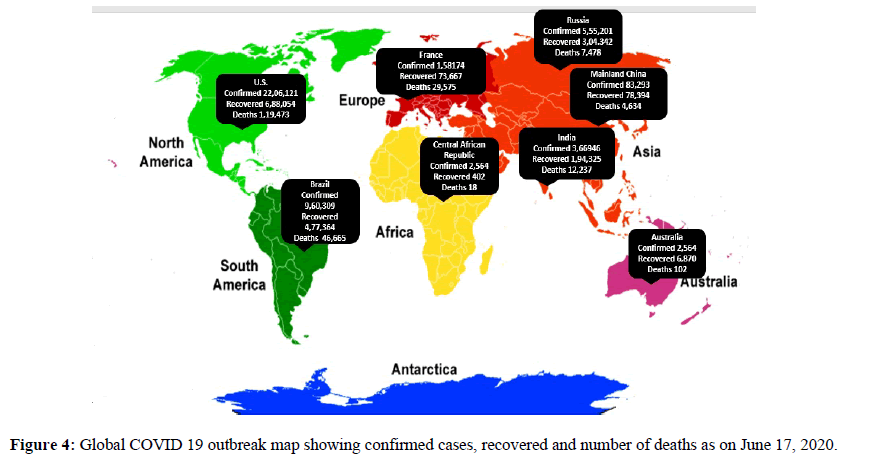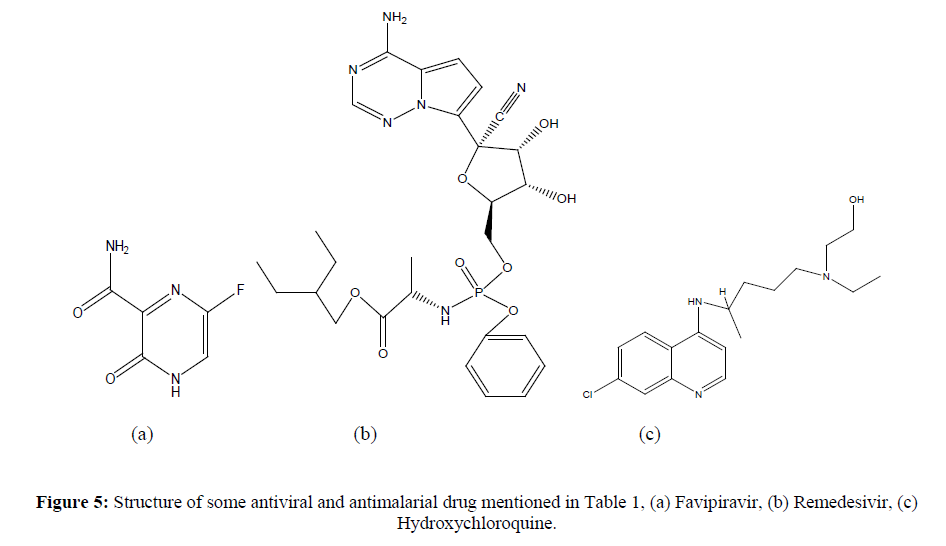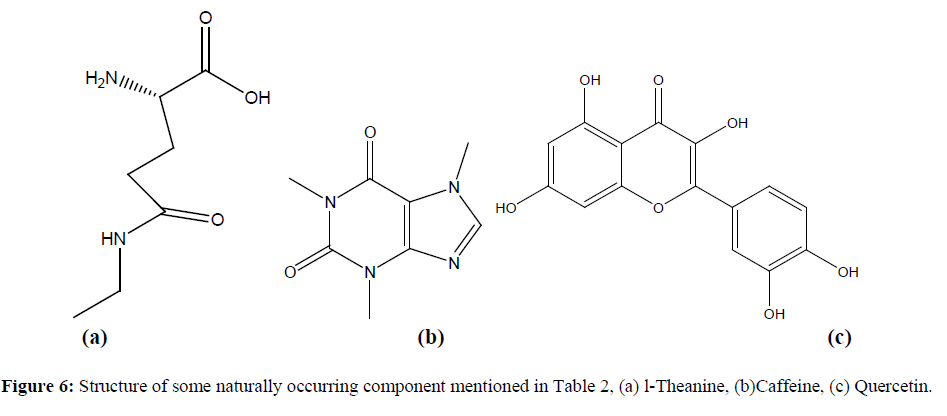Mini Review - Der Pharma Chemica ( 2020) Volume 12, Issue 4
In Search of Remedy: a Chemistry-Based Postulation to find Out Drugs to Combat COVID19
Biplab De1 and Ashmita Saha2*2Department of Pharmaceutical Sciences, Dibrugarh University, Dibrugarh, Assam, India
Ashmita Saha, Department of Pharmaceutical Sciences, Dibrugarh University, Dibrugarh, Assam, India, Email: ashmita1785@yahoo.com
Received: 17-May-2020 Accepted Date: Jul 15, 2020 ; Published: 30-Jul-2020
Abstract
Respiratory syndrome related corona virus (SARS-CoV-2) is a new pathogen causing pandemic. People throughout different countries are quarantined with loss of social life and economy. Physicians are generally using drugs for symptomatic treatment including chloroquine etc. Researchers are working to make way out of this pandemic virus keeping in mind the treatment regimens of other pathogens of respiratory tract infection followed by boosting the immunity of the patients. Natural components are in use to get relief from viral infections and as immunity enhancers. Considering mechanism of action and chemical structure of drug component in use, this article aimed at a mini review to postulate that fused heterocyclic moieties with the functional group’s carboxylic acid, amines, hydroxyl etc. may be considered in designing antiviral drugs for SARS-CoV-2.
Keywords
COVID19, Drug remedy, Natural approach
Introduction
Severe acute respiratory syndrome related corona virus (SARS-CoV-2) is a new virus that is highly infectious, can spread quickly, taking lives of more than 4.5 lakh people [1] throughout the world until now and expecting an increase in number onward. The virus is unique among human coronaviruses in its combined ability of high transmissibility within human including fatal outcomes in immuno-compromised patient. The whole world is experiencing quarantined with no social life and loss of world economy [2].
The outbreak of novel corona virus was first experienced at 2019 end in Wuhan, China. It killed more than eighteen hundred and infected over many thousand individuals within the first fifty days of the epidemic. The novel virus was termed as Wuhan coronavirus or 2019 novel coronavirus (2019-nCov) by the Chinese researchers. The International Committee on Taxonomy of Viruses (ICTV) named the virus as SARS-CoV-2 and the disease as Covid-19 [3,4]. On 7th January, 2020, the virus was isolated initially from a clinical sample that results in Covid 19 infection. Most infected patients were found in the age group of 30 to 69 years. Mortality rate is more in elderly immuno-compromised patients, with special mention to diabetic, asthma and cardiac patient.
Countries all over the world have put in lockdown in places and maintaining public health measures to ensure physical distancing and good health hygiene. Testing and tracing of contacts of people with COVID 19 followed by isolation of COVID 19 patient are going on to reduce spread of the infectious virus among the mass of population.
Governments with the help of WHO (World Health Organisation) and other partners rapidly scaled up health workforce and laboratory capacities. Thermal screening is going on at entry and exit points of airports as well as border crossing. Spread of the infection by asymptomatic person is still under observation by WHO.
Antiviral drugs targeting human corona virus is necessary that could be used against the present as well as future epidemics. This article shows study on a chemistry-based postulation to choose a drug to combat the COVID19.
Structural and Functional Characteristics of the Virus Sars-Cov-2 and Pathogenesis
Corona viruses are under the virus family Corona viridae of order Nidovirales. The name corona virus is due to crown like spikes (corona) on the outer surface of the virus. Corona viruses are minute in size (65 nm-125 nm in diameter) having a single-stranded RNA as a nucleic material, size ranging from 26 kbs to 32 kbs in length [5]. The corona virus family have subgroups alpha (α), beta (β), gamma (γ) and delta (δ) corona virus, while SARS-CoV-2 was reported to be a beta coronavirus. SARS- CoV-2 possesses the typical corona virus structure having spike protein and other polyproteins. The spike protein is the leading mediator of viral entry and have important role in determining host range. The distinctive “corona” or crown-like appearance is due to the formation of trimers on the virion surface [6]. Other polyprotein includes nucleoproteins and membrane proteins, such as RNA polymerase, 3-chymotrypsin-like protease, papain-like protease, helicase, glycoprotein and accessory proteins [7].
The invading mechanism of corona virus happens by cellular proteases including, human airway trypsin-like protease (HAT), transmembrane protease serine 2 (TMPRSS2) and cathepsin, that leads to split of spike protein and pave the way to further penetration. The glycoprotein spikes determine attachment and entry inside the host cell. The virus may infect multiple hosts since the receptor-binding domain is loosely attached among virus. The spike protein of SARS-CoV-2 is a 3-D structure in the RBD region [8,9].
Encoded proteins for viral replication, nucleocapsid and spikes formation are possessed by all forms of coronavirusin specific genes in (open read frame) ORF1 downstream regions. While other corona viruses mostly recognize key receptor such as aminopeptidases or carbohydrates to get entry into human cells, SARS-CoV and MERS-CoV recognize exopeptidases. HCoV-NL63 and SARS-corona virus require angiotensin-converting enzyme 2 (ACE2) as a key receptor whereas MERS-corona virus employs dipeptidyl peptidase 4 (DPP4).
It was confirmed in fluorescent study that the SARS-CoV-2 uses ACE2 (angiotensin-converting enzyme 2) cell receptor to get entry into host cell similar to that of SARS-CoV previously. The ectodomain of all Corona virus spike proteins comprised of two domains namely an N-terminal domain also called S1, responsible for receptor binding and a C-terminal also called S2 domain, responsible for fusion. S1 possess the receptor binding domain (RBD) to directly bind to the peptidase domain (PD) of ACE2 and S2 plays a part in membrane fusion [10].
The main signs and symptoms of Covid-19 include fever with dry cough, fatigue, shortness of breath with sputum production, myalgia or arthralgia, and sore throat with headache. A small percentage of patients reported nausea and vomiting. Covid-19 patients often get admitted to hospital with symptoms similar to pneumonia.
So, the virus primarily attacks upper respiratory tract with inflammation and damaging the epithelial lining of upper respiratory tract in later stage. The protective barrier in lungs where oxygen gets absorbed, comprises of a single monolayer of epithelial cells with a protective mucus layer. The cilia present over there sweeps the mucus and trapped bacteria and debris up and out of the lung [11,12] Severe inflammation and damage of the respiratory epithelium ensues breathing problem in individual and mortality in immuno-compromised individuals more often.
Other pathogens of respiratory tract infection
Bacteria and parasites, invading human host carry the basic genetic information necessary for their own metabolism and replication, and take nutrients from host cell. In contrary, viruses, utilise basic host cell machinery for viral reproduction. Viruses depend on host cell ribosomes to produce proteins, and some utilises host cell DNA and RNA polymerases for replication and transcription, respectively [13].
Viruses that infects the upper respiratory tract other than corona virus are respiratory syncytial virus (RSV), parainfluenza (PIV), influenza A (IA), rhinovirus (RV), adenovirus (AD), human metapneumovirus (hMPV), human bocavirus (HBoV). All individuals can be infected by these viruses. The influenza virus makes entry into host cell using the globular heads of the viral hemagglutinin (HA) which mediate binding of the virus to sialic-acid-containing cell-surface receptors [14].
Common bacterial pathogens causing upper and lower respiratory tract infections are Streptococcus pneumoniae, Haemophilus influenza, Moraxella catarrhalis. Some organisms constitute part of the flora of the upper respiratory tract of healthy adults. Otitis media, pneumococcal disease in children is caused when microbes of normal flora invades the protective epithelial lining. Whooping cough in children is caused by Bordetella pertussis [15,16]. The first step in a B. pertussis infection is colonization of the respiratory epithelium. The bacteria tightly get bonded on the surface of the ciliated cells, and multiplying on them, inhibitting normal clearance mechanism. This leads to paroxysmal coughing. In adolescents and adult pneumococcal disease cause lobar pneumonia. Pneumonia caused by S. pneumoniae gets complicated, when the bacteria invades blood stream. The pneumococcal cell surface uses autolysis as a mechanism to facilitate exchange of genetic material (releasing DNA into the surrounding environment). This mechanism promotes inflammation [17]. Pneumococci release pneumolysin, that causes all of the symptoms of pneumococcal pneumonia. Pneumolysin, a protein that binds to immunoglobulin and directly activates complement, also has direct cytotoxic effects on lung epithelial tissue. Mycobacterium tuberculosis cause a serious lung infection in some urban area called tuberculosis. This bacterium is usually acquired by inhalation into the lungs, where alveolar macrophages phagocytose it. The microbe can survive and replicate within macrophages and in some cases by the immune system of the host, a lesion is produced, called tubercle [18]
Respiratory system has its own defence mechanisms by mucociliary transport, local production of immunoglobulins and phagocytosis. Infections of the upper respiratory tract get worsen when these mechanisms are inhibited by viral infection or by exposure to environmental stressors such as tobacco smoke or dust [19].
It needs to mention here, that antibiotics used at present to treat respiratory tract infection caused by bacteria are with fused heterocyclic ring system similar to that of some antiviral drugs.
The present pandemic scenario in India and in the World
As on 18th June 2020, there were 378,171 active cases, 201, 297 cured, 1 migrated and 12,539 deaths in India is reported. Figures 1-6 shows the increase in number of new cases in India and the increase in number of death of patients with COVID19 respectively.
WHO country officer for India continues to work closely with ministry of health and family welfare (MoHFW) to prepare and take measure including surveillance, testing, case management, containment and research activities for COVID 19. Special focus is on high burden cities such as Delhi in north, Chennai in south and Maharashtra in west. WHO continues to support Indian council of Medical Research (ICMR) in increasing the testing capacity of the country. ICMR tested total of 56,58,614 samples as on 14th June 2020, 9 am IST.
In search of probable drugs to treat Covid-19 patient
Till date no specific antiviral drug is found to treat SARS-CoV-2. Researchers and scientist from all over the world are working hard to make way out of this pandemic virus keeping in mind the treatment regimens of other pathogens of respiratory tract infection followed by boosting the immunity of the patients. Physicians are generally using drugs for symptomatic treatment. Some of those medicines [20-23] are depicted below (Table 1).
Table 1: Generally using drugs for symptomatic treatment
| Sl. No. | Name of the Drug (Category) | Probable Mechanism of Action in Human Body | Main Chemical Moiety Present & Functional Groups |
|---|---|---|---|
| 1 | Remdesivir (Antiviral against Ebola virus) | A nucleotide analogue that may block viral nucleotide synthesis to stop viral replication | Amino, Pyrrole, Triazine, Dihydroxytetr: ahydrofuran, Phosphoryl amino propanoate |
| 2 | Favipiravir (Anti-viral) | A purine nucleoside that acts as an alternate substrate leading to inaccurate viral RNA synthesis | Pyrazine-carboxamide, Fluorine, Hydroxyl |
| 3 | Choloroquine (particularly Hydroxy Choloroquine) (Antimalarial) | A drug that can elevate endosomal pH and interfere withACE2 glycosylation | 4-Aminoquinoline, Oxychloroquine, Aminoethanol |
| 4 | Immunoglobin (IGg) (Antibody; glycoprotein) | By binding many kinds of antigens - pathogens, protects body from infection and aiding in their destruction by blocking Fc receptors of phagocytes followed by formation of idiotype - anti-idiotype dimers. | Large globular protein made of four peptide chain |
| 5 | Baricitinib (In Rheumatoid arthritis) | A JAK inhibitor that may interfere with the inflammatory processes | Azetidineacetonitrile, Ethylsulfonyl pyrrole, Pyrazole, Pyrimidine |
| 6 | Lupinavir (Anti-HIV) | Protease inhibitors that may inhibit the viral proteases: 3CLpro or PLpro | Dicarboxylic acid amide |
| 7 | Ritonavir (Anti-HIV) | It is a pharmacokinetic profile enhancer that may potentiate the effects of other protease inhibitors due to its ability to attenuate the degradation of those drugs by the liver enzyme CYP3A4 and thus is used in combination with antivirial Lopinavir | Diphenyl hexan carbamate, Alkyl amino, Alkyl thiazol. |
| 8 | Arbidol (In Influenza antiviral) | An inhibitor of viral entry to host cells and an inhibitor that may disrupt the binding of viral envelope protein to host cells and prevent viral entry to the target Cell | Indole-3-carboxylic acid, Alkyl bromo, Alkyl hydroxyl, Phenylsulfonyl |
| 9 | Nitazoxanide (Anti- helminthic, protozoal, and viral infection-caused diarrhea) | A drug that may inhibit viral protein expression | Benzamide, Nitro-thiazole |
| 10 | Interferon–Human Serum albumin fusion protein (e.g. Interferon alpha 2b) (Anti-viral) | Significantly lengthened the plasma half-life of interferons due to slower free interferon release into the plasma and thus may prolong the effects of interferon for each injection. Interferons are a group of signalling proteins made and released by host cells in response to the presence of several viruses. | Interferon alpha is monomeric, composed of a single chain and two different receptor chain bind to two different portion of the protein |
| 11 | Ribavirin(Anti-RSV infection, hepatitis C, some viral hemorrhagic fevers) | A nucleotide analogue that may block viral nucleotide synthesis to stop viral replication | Purine analogue |
In search of natural remedies to treat Covid-19 patient
Plant products especially secondary metabolites obtained from medicinal plants may take part in plant-microorganism and plant-plant interactions and are termed as allelochemicals. In plants, allelochemicals can be present in the leaves, bark, root, flowers and fruits and can have beneficial or detrimental effects on the target organisms and community. Alleolochemicals include flavonoids, terpenoids, saponins, tannins, alkaloids and aromatic acids etc. As an example, flavonoids have been reported to have antimicrobial, antiviral, antitumor, cardiovascular, molluscicidal, spermicidal, cytotoxic, antimutagenic, antiulcerogenic, anti-inflammatory, antioxidant and antiaging activities. Few of those natural components are in use to get relief from flu, COVID19 and other viral infections and as immunity enhancers [24-26] are depicted below (Table 2).
Table 2: Other viral infections and as immunity enhancers
| Sl. No. | Name of the natural component with source (Category) | Probable activities in human body, may help to treat COVID19 | Main chemical moiety present & functional groups |
|---|---|---|---|
| 1 | l-Theanine from black or green tea (Immunity enhancer) | l-Theanine is broken down in liver to ethylamine, a molecule that primes the response of an immune blood cell called the gamma-delta T cell. T-cells prompt the secretion of interferon. | N-ethyl L glutamine |
| 2 | Caffeine, Theobromine, Theophylline from tea (Stimulant) | May abort an asthma attack by relaxing constricted bronchial muscles | Purine, Alkyl, Ketone |
| 3 | Quercetin (Flavonoid) from Onions, apples, berries, black grapes, kale, broccoli, red wine (Antioxidant) | Helps to maintain and improve proper function of heart and lungs and lowers the risk of respiratory diseases | Flavonoid with hydroxyl group |
| 4 | Proteins from whey, animal meat, pulses, milk, eggs etc. (Immunity enhancer) | To make antibodies | Alkyl, Aryl, Amino, Carboxylic |
| 5 | Omega-3 & 6 fatty acids from fish, seafood (Immunity enhancer) | Beneficial in controlling inflammation and harmful effects of rheumatoid arthritis and other autoimmune disorders. Activate immune system. | n-3-Poly-unsaturated fatty acid, eicosapentanoic acid |
| 6 | Vitamin E, C, A from oils, nuts, seeds, margarine, avocados, fruits, vegetables, capsicums, cheese, citrus fruits, tomatoes, other plant foods (Immunity enhancer) | E may enhance T cell activity and assist in the production of antibodies. C assists in building and maintaining mucous membrane and collagen and enhances the function of the immune cells. A reduces the incidence and severity of infectious illnesses by helping to keep mucous membranes healthy and intact and may also increase antibody response and white blood cell proliferation | Tocopherols, Ascorbic acids, Beta ionone ring with isoprenoid ring |
| 7 | Probiotics from Yoghurt (Immunity enhancer) | Help to improve immune responses. | ------ |
| 8 | Ouabain from Strophanthus plant (Cardiac glycoside) | To treat congestive heart failure and superventricular arrhythmias due to re-entry mechanisms and to control ventricular rate in the treatment of chronic atrial fibrillation | Cyclopentanophenanthrene (Steroidal), furan, hydroxyl |
Discussion and Conclusion
The entry and spreading of Corona virus (SARS-CoV-2) among the people cannot be stopped without maintaining of physical distancing. Virus will not be able to make sick or to kill human, if already the particular antibody is present in the healthy human; but it is possible that time only if respective vaccination taken place. After entry of virus in upper respiratory tract, the virus should be killed or the entry in lower respiratory tract should be restricted. Initially, hydroxychloroquine was applied. But hydroxychloroquine is not confirming to kill the virus, though patients (not all) are responding. Hydroxychloroquine elevates endosomal pH and interferes with terminal glycosylation of the cellular receptor i.e. angiotensin converting enzyme 2, thus it may negatively influence the virus receptor binding and so may result inhibition of infection and spreading of virus. However, based on WHO solidarity trial data, hydroxychloroquine did not show any reduction of mortality in hospitalised COVID 19 patient. The effected mucous layer of respiratory epithelial can be healed by increasing the immunity, which can be achieved by applying vitamins A, C & E. Further for antibody formation and inflammation recovery, patient needs protein in diet and Omega3 fatty acids. In addition, for enhancing of immunity and stimulation purpose, one can take green tea. Based on clinical symptoms, physicians and dieticians may apply drugs and food accordingly. At present situation, based on availability of drugs and knowledge, antiviral drugs are given to the patients, assuming either may block viral nucleotide synthesis to stop viral replication or may inhibit viral protein expression or may inhibit viral enzymes etc. In some cases, cure is recorded, but can’t be accepted universally. One more example is the recent use of Dexamethasone, a corticosteroid that appeared as lifesaving for patient in ventilators. So need of the hour is to synthesize antiviral drugs to kill SARS-CoV-2 and to cure patient already effected by the virus, otherwise the social and economic impact due to the SARS-CoV-2 will get worsen day by day. In this compilation, different synthetic and natural compounds, targeted to be used or in use are enlisted in table 1 and 2 respectively. The main chemical moiety present and functional groups in different drugs and components are mentioned along with respective mechanism of action. On structural analysis of those and considering the mechanism of activities of those, it can be postulated that fused heterocycle with the functional groups- carboxylic acid, amines, hydroxyl etc. may be considered in designing of the antiviral drugs for SARS-CoV-2 with least toxicity to host cell.
Ethical Approval
No ethical approval required.
Sources of Funding
No funding received.
Author Contributions
Conceptualization by B. De, Data curation, analysis and interpretation, writing original
Draft by A. Saha. B. De and A. Saha: critical revision and editing. All authors read and approved the final manuscript.
Declaration of Conflict of Interest
The authors declare no conflict of interest.
Acknowledgements
The sincere effort of communities around the world to reduce the impact of COVID 19 pandemic on vulnerable population are deeply acknowledged.
References
[1] Coronavirus Update (Live): 8,513,489 Cases and 453,483 Deaths from COVID-19 Virus Pandemic - Worldometer [Internet]. Worldometers.info. b [cited 18 June 2020].
[2] Report of the WHO-China Joint Mission on Coronavirus Disease 2019 (COVID-19).
[3] M. Shereen, S. Khan, A. Kazmi et al., J. Adv Research. 2020, 24: p. 91-98.
[4] S. Belouzard, J. Millet, B. Licitra, et al., Viruses. 2012, 4(6): p. 1011-1033.
[5] N. Wang, Shi X, Jiang L et al., Cell Research. 2013, 23(8): p. 986.
[6] M. Christian, S. Poutanen, M. Loutfy et al., Life Sciences. 2020, 253: p. 117592.
[8] SJ. Flint, LW. Enquist, RM. Krug et al, ASM Press Washington D.C. 2000.
[9] E. Gottwein and BR. Cullen. Cell Host Microbe. 2008, 3(6): p. 375-387.
[10] Schneider-Schaulies J. J Gen Virol. 2000, (81): p. 1413-1429.
[11] Drug Target Review. 2020. Self-Assembling Biomaterial Could Be Used to Model Vascular Structures, 2020.
[12] Ma. Eugenia Manjarrez-Zavala, Carlos Cabello-GutieÌrrez, Dora Patricia Rosete-Olvera et al., INTECH. 2013.
[13] B. Alberts, A. Johnson, J. Lewis et al., Cell Biology of Infection. 2002.
[14] D Cappelletty. ``Pediatr. Infect. Dis. J. 1998, p. S55-S61.
[15] E Crouch. Respiratory Research. 2000, 1(2).
[16] L Liu, Q Wei, X Alvarez et al., J. Med. Virol. 2011, 85(8): p. 4025-4030.
[17] Y Yang, Y Huang, Y Chuang et al., J. Med. Virol. 2005, 77(1): p. 1-7.
[18] T Albrecht, M Fons, I Boldogh et al. Effects on Cells. In: Baron S, editor. Medical Microbiology.4th edition. Galveston (TX): University of Texas Medical Branch at Galveston; 1996.
[19] Lu H, C Stratton, Y Tang. J. Med. Virol. 2020, 92(4): p.401-402.
[20] C. Liu, Q. Zhou, Y. Li et al., ACS Central Science. 2020, 6(3): p. 315-331.
[21] F. Sanchis-Gomar, C. Lavie, C. Perez-Quilis et al., Angiotensin-Converting Enzyme 2 and Antihypertensives (Angiotensin Receptor Blockers and Angiotensin-Converting Enzyme Inhibitors) in Coronavirus Disease 2019.
[22] MCZ. Novaretti and CL Dnardo. Rev. Bras. Hematol. Hemoter. 2011, 33(5): p. 377-382.
[23] RN Yadava, 2019. Recent trends in chemical sciences, Everyman’s Science, LIV (2), p. 75-76.
[24] R. Stanton. Foods that harm foods that heal. 2nd edition. Sydney: 2006.
[25] PubChem [Internet]. Pubchem.ncbi.nlm.nih.gov. 2020
[26] N. Zhong, B. Zheng, Li Y et al., The Lancet. 2003, 362(9393): p. 1353-8.

